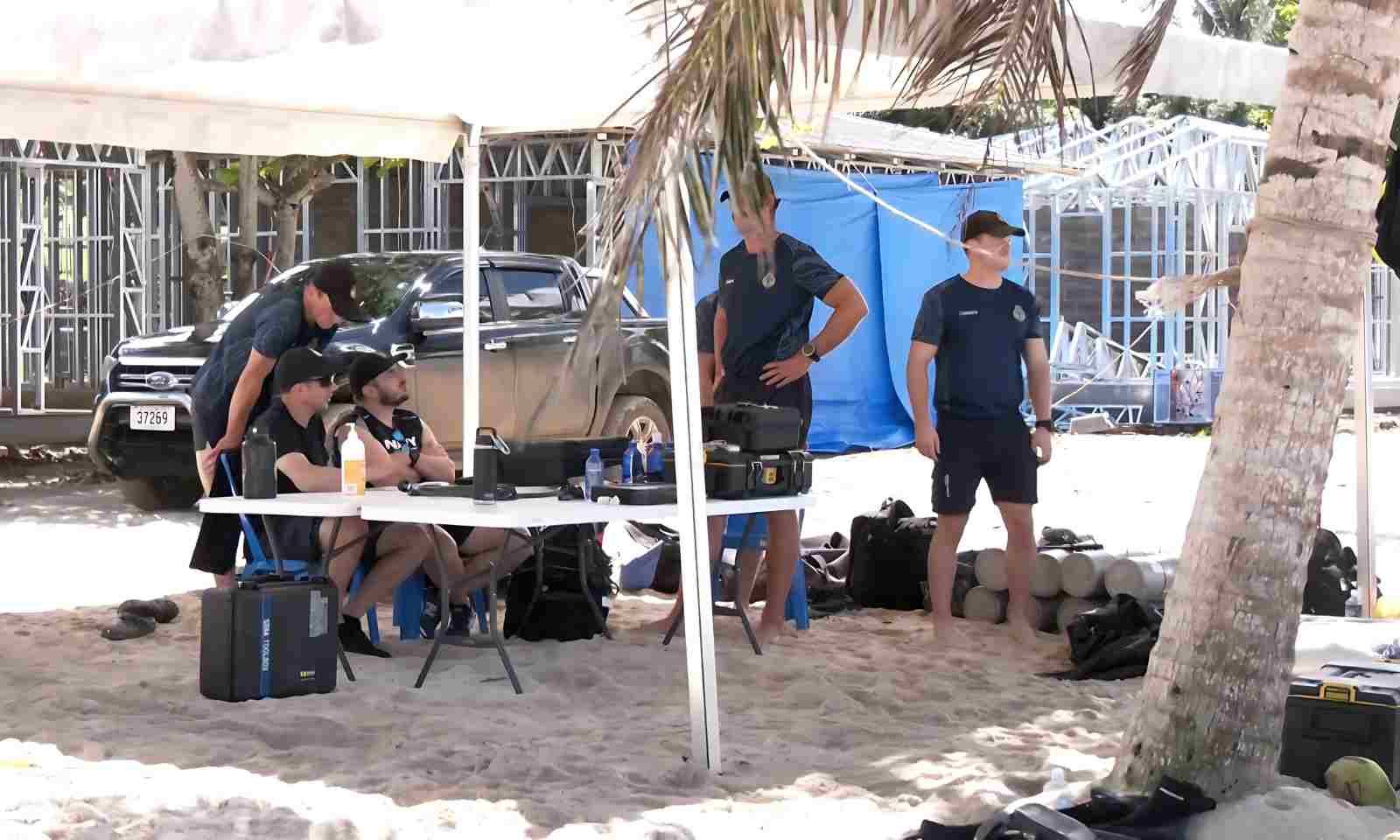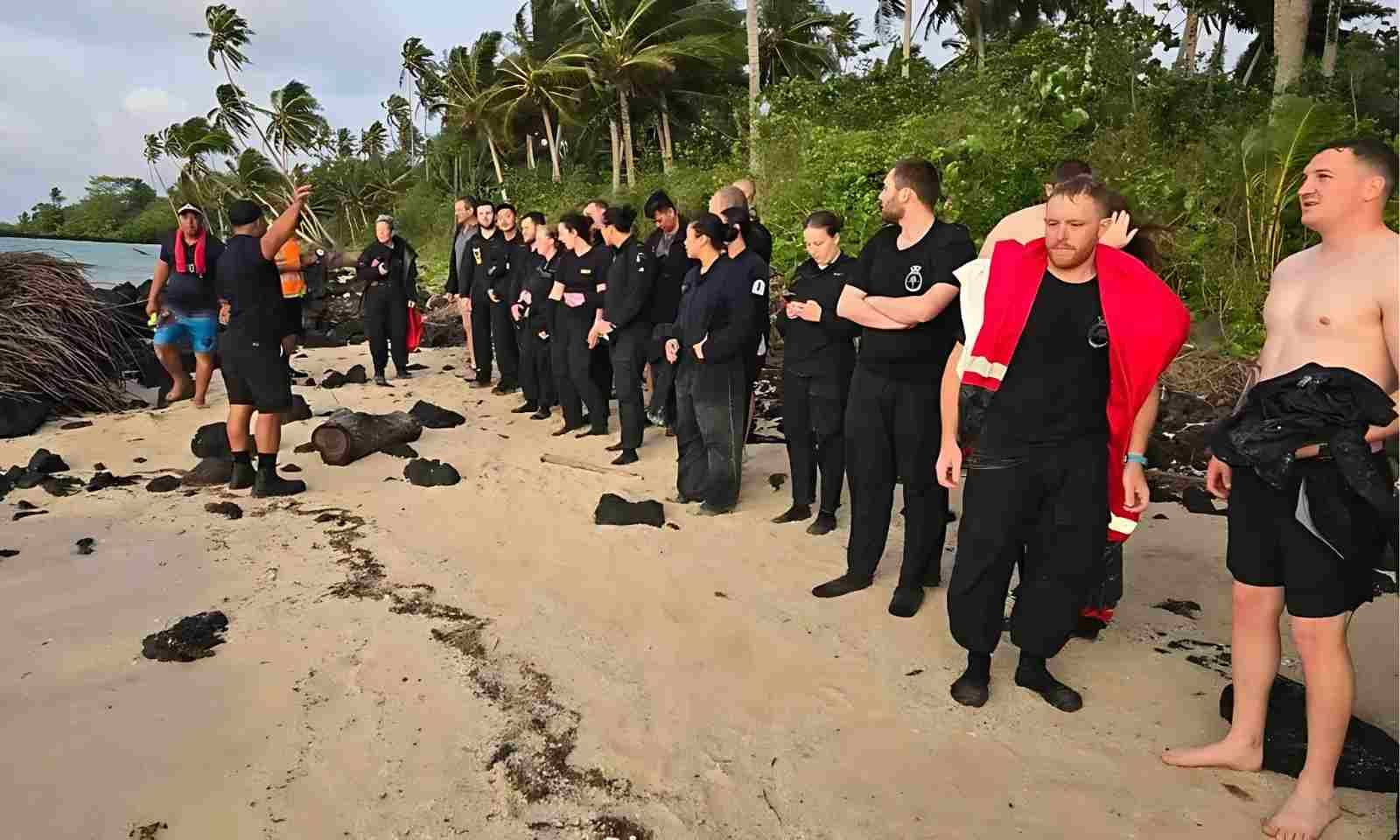

Sāmoan villagers living along the coastline from the districts of Safata to Lefaga have been cautioned against fishing in the area.
Photo/supplied
HMNZS Manawanui: Sāmoan villagers urged not to fish as leaks confirmed on stricken ship
Officials say the primary area of damage is around the reef where the naval vessel went down.
Sāmoa's Marine Pollution Advisory Committee (MPAC) has confirmed that the HMNZS Manawanui is leaking “residual oil” from three locations of the stricken naval ship.
And this has led to nearby villagers being urged not to fish along a 20km coastline from the districts of Safata to Lefaga.
The villages of Tafitoala and Maninoa have a clams reserve and a big turtle population that the residents fear could be at risk.

NZ Navy personnel are in Sāmoa to assist in the cleanup following the sinking of HMNZS Manawanui. Photo/supplied
The HMNZS Manawanui, a specialist dive and hydrographic vessel, lost power and ran aground on Saturday evening while conducting a reef survey one nautical mile off the southern coast of Upolu Island in Sāmoa.
Divers from New Zealand and Sāmoa have completed several assessments on the extent of the leaks.
Sāmoan and New Zealand officials say a daily sweep of the 20km coastline, from the districts of Safata to Lefaga and the lagoon, will continue for any signs of contamination and debris.
Leading the New Zealand delegation at an MPAC briefing on Thursday was Deputy Chief of Navy, Commodore Andrew Brown, who conveyed Aotearoa’s “sincere appreciation to the Sāmoan people for the emergency response provided to the crew of Manawanui and the hospitality that was extended to them up until they were farewelled”.
MPAC chair Fui Tupai Mau Simanu told journalists the primary area of damage around the reef is about 5000 square metres.
Fui and his team met with New Zealand Defence Force (NZDF) and Maritime officials on Thursday.
The NZDF said 950 tonnes of diesel were on board when the Manawanui went down.
Tafitoala Village head Taloaileono Vasasou told PMN News they have been cautioned not to fish in Tafitoala, Mulivai, and parts of Si'umu waters that are within the 20km coastline from Safata to Lefaga.
He said the villagers have expressed concern over the potential impact the marine disaster could have on the environment.
“The villagers heavily rely on the sea for our daily food, and we are worried that oil from the ship may leak, causing damage to our marine resources.”
In a statement, MPAC said the oil leakage stemmed from the service tanks in the engine room where a fire broke out.
Preliminary investigations by MPAC and the NZDF, in collaboration with Sāmoa’s Ministry of Natural Resources and Environment (MNRE), show that “while the leak continues, it is reducing each day”.
“The residual oil leakage is from the service tanks of the vessel where the engine room is and where the fire had broken out,” the committee said.
“It is believed that the majority of the fuel was burnt out, and it is the residual oil that is emanating from the sunken vessel.
“The oil sheens observed on the surface of the ocean has been observed to naturally evaporate and dissipate quickly due to the strong winds in the area.
Tour operator Brent Ross went out on his boat to assess the situation for his guests who were scheduled to explore the popular surfing spot where the Manawanui sank.
“It is important to note that there continues to be no trace of oil contamination that has washed up onshore, as of 8am today, October 10.
“It is imperative to contain the persisting leakages; whilst it is reducing, the goal is to stop it as soon as possible.”
A community engagement programme was held at Tafitoala Village on Thursday, led by the MNRE, to ensure the local communities were “informed about the right information about this matter”.
The removal of Manawanui’s anchor and three washed-up containers from the ship, caught on the reef off the coast of Tafitoala, was also discussed in Thursday’s meeting with the “focus on how to do so without causing more damage to the reef”.
Dr Bridie Allan, lecturer, Department of Marine Science, at the University of Otago, Ōtākou Whakaihu Waka says it appears as though surface oils are dissipating quickly.
“However, this does not reduce the risk of contamination. For example, as oil is agitated at the surface due to wave and wind energy, the chemical components, including highly toxic heavy metals and polyaromatic hydrocarbons (PAHs), in the oil are weathered out.

More than 70 crew and passengers were rescued off the HMNZS Manawanui. Photo/Royal New Zealand Navy
“This results in the release of these chemicals into the water column where marine organisms may encounter them.
“Very small doses of these chemicals have been demonstrated across multiple scientific studies to cause a range of physiological effects such as cardiac, spinal and craniofacial deformities as well as behavioural impairments following exposure to low levels of PAHs.”
Allan says it also seems likely that increasing levels of oil will be released over the coming days “presenting more of a significant threat to this ecologically and economically important ecosystem.
“The effects of a catastrophic oil spill can persist over a long period as the chemical components of oil are absorbed by marine organisms and deposited in marine sediments.
“This can continue to have lasting effects of the fitness of populations of exposed animals.”
The NZ Navy says a team of 50 people are on the ground helping in the cleanup.


